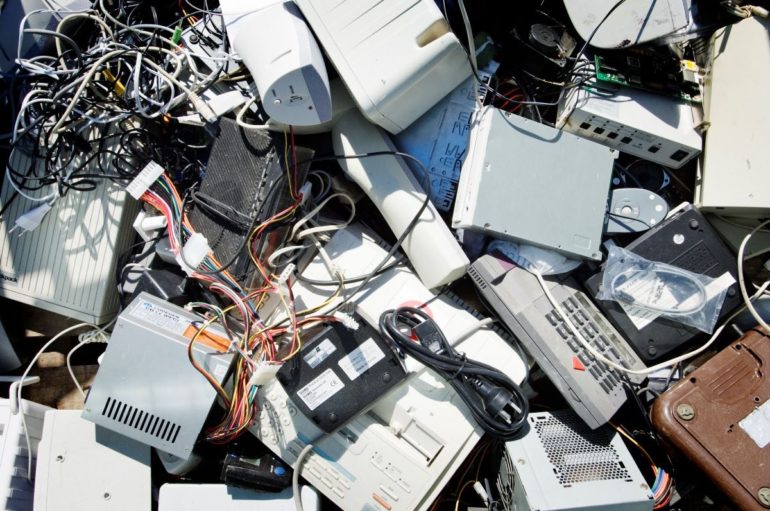One of the main reasons for the explosion of global e-waste generation is the high consumption rates of electronics.
Image: Richard Clark / The Image Bank / Getty Images
From defective household electronics to old smartphones: the total amount of e-waste generated around the world this year is estimated to reach a record 57.4 million tonnes — that is, more than the weight of the heaviest artificial object on Earth, the Great Wall of China.
This mountain of waste electronic and electrical equipment (WEEE) is only set to get bigger. According to a new report published by the international organization, the WEEE Forum, e-waste is on course to increase by up to 4% every year to reach 74 million tonnes by 2030.
One of the main reasons for the explosion of global e-waste generation is the high consumption rates of electronics, which the WEEE Forum says is increasing by 3% annually. This is particularly noticeable when looking at the smartphone industry. On average, consumers replace their mobile devices every three years, and up to one billion handsets ship every year across the world.
See also: Raspberry Pi boards are now being recycled – at the same factory that made them.
The problem is that few consumers know what to do with the devices they are replacing — and more often than not, they end up sleeping at the back of a drawer or going straight to a landfill. Estimates indicate that the average household in Europe is home to 11 items that are no longer in use or broken. Every citizen is sitting on up to five kilograms of unused electrical and electronic products.
And when devices aren’t put away in a conveniently labeled “old electronics” box, they are often trashed with no regard to where they will end up. According to the WEEE Forum, 151 million mobile phones are trashed every year, ending up incinerated or landfilled in the US. Up to 40% of heavy metals in the country’s landfills, as a result, comes from discarded electronics.
One way to tackle the challenge of e-waste is to recycle old and unused devices. But the easy options of trashing the items or hiding them from view added to various factors such as fear for data security or difficulty of reaching return points, mean that recycling levels are still pretty low across the globe.
While members of the public estimate that about half of e-waste is currently recycled, the reality is much bleaker: just a little over 17% of electronics were known to be properly treated and recycled in 2019.
Yet recycling has a huge role to play in reducing the industry’s environmental footprint. Smartphones, for example, require lots of resources to be built, with analysts estimating that the total carbon footprint of the manufacturing process is equal to the annual carbon emissions of a small country. If some of the resources could be recycled from older devices, reducing those numbers could go a long way.
For example, the recovery of some materials like gold from waste saves a lot of carbon dioxide emissions when compared with mining more, said experts from the WEEE Forum.
“Every tonne of WEEE recycled avoids around two tonnes of CO2 emissions,” said Pascal Leroy, the director-general of the WEEE Forum. “If we all do the right thing with our e-waste, we help to reduce harmful CO2 emissions.”
See also: Don’t buy that expensive new iPhone 13: How used iPhones can deliver huge savings.
The gains are not only environmental: the recoverable materials in old electronics also have financial value. One tonne of discarded mobile phones, for example, contains more gold than a tonne of gold ore.
And one million cell phones could generate 24 kilograms of gold, 16,000 kilograms of copper, 350 kilograms of silver and 14 kilograms of palladium. In 2019, the value of this type of raw materials in e-waste was valued at approximately $57 billion, of which only $10 billion was recovered.
The onus is now on consumers to take responsibility for their electronic waste, said the WEEE Forum. “One thing stands out: as long as citizens don’t return their used, broken gear, sell it, or donate it, we will need to continue mining all-new materials causing great environmental damage,” said Leroy.
This means it is necessary to raise awareness among consumers, but also to make it easier for them to recycle thanks to an appropriate and convenient infrastructure.
See also: Europe wants to be a computer chip powerhouse again. It’s not going to be easy.
Industrial players, therefore, have a role to play, too. Many equipment manufacturers like Apple or Samsung already have recycling programs in place, which encourage users to send their old phones to dedicated recycling centers or prompt them to trade in their devices for credits towards their next purchases.
Fairphone, a small sustainable phone manufacturer based in the Netherlands, has opted for an even more radical approach. Rather than focusing entirely on recycling old products, the company sells devices that are designed to last a lot longer than the average smartphone’s three-year lifetime.
The products sold by Fairphone are modular, which means that users can easily replace or update some of the components in their phone if they break or become too old — think screens, but also batteries or headphone jacks. The company hopes that this model will let owners hold on to their handsets for up to five years.
“What is actually more efficient than recycling is to keep using devices,” Matthew Cockerill, a consultant in strategic design, who previously helped launch Fairphone’s first handset. “Do we have to throw our products away and make totally new ones, or can we look at things like re-manufacturing, where a smartphone could be taken back and upgraded, with a few things replaced but where essentially most of the components would last much longer?”
Longer lifecycles for electronic devices ultimately means that less carbon is emitted to produce new ones – as well as less e-waste. It might be worth thinking twice, therefore, before upgrading your handset — and sending it to join its predecessors in that kitchen drawer.



